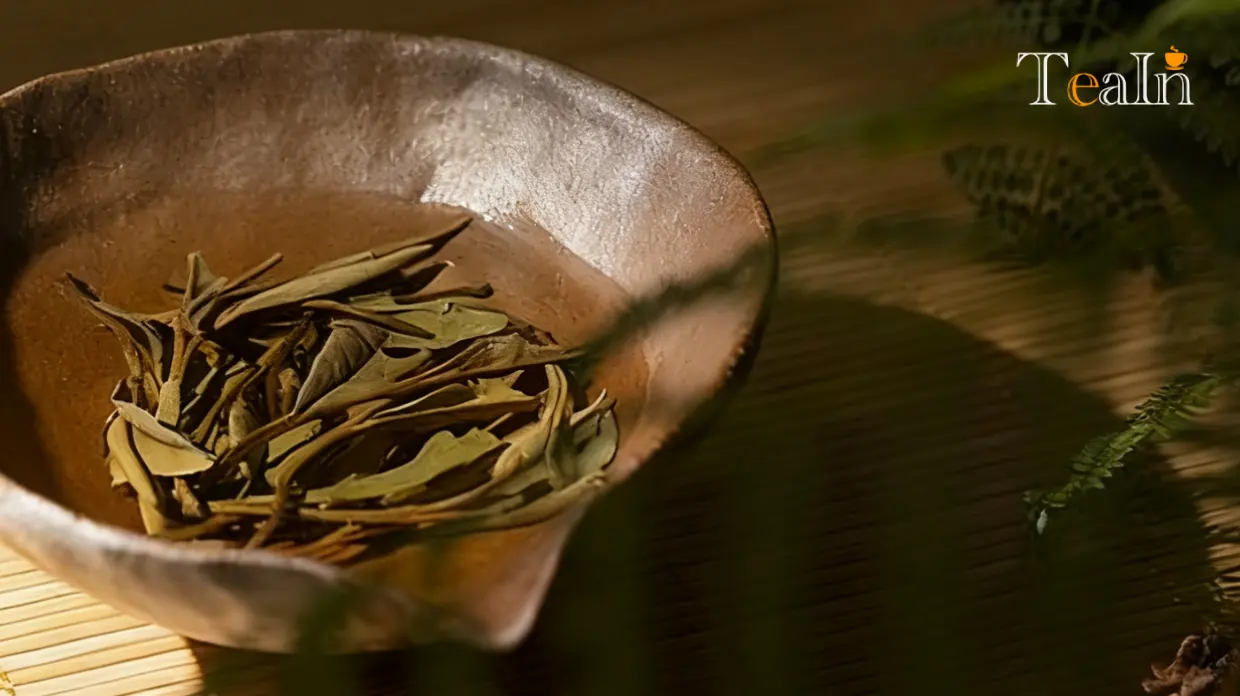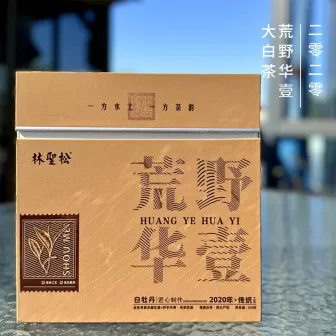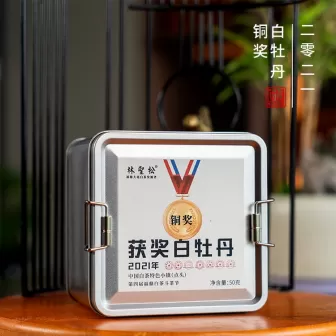White Peony White Tea: The Elegant Gem of White Teas, Savor Spring’s Floral Aroma in Every Sip

When talking about white tea, some favor the rarity of Silver Needle, while others enjoy the richness of aged Shoumei. But if there’s one that perfectly balances "appearance, taste, and value for money," it’s White Peony White Tea. Named for its dried form—where buds and leaves remain attached, resembling budding peonies—it combines the freshness of Silver Needle with the mildness of Shoumei. Like an "elegant lady," it has become many people’s first choice for entering the world of white tea, and a "favorite daily sip" for seasoned tea lovers. Today, we’ll walk you through its origin, raw materials, craftsmanship, and tasting to help you understand this "blooming white tea."
I. What Is White Peony White Tea? The Backbone of White Teas
White Peony sits as the "backbone" among the four major white tea categories (Silver Needle, White Peony, Gongmei, Shoumei). It ranks just below Silver Needle in grade but is more refined than Shoumei and Gongmei. Its core feature lies in its picking standard: either "one bud with one leaf" or "one bud with two leaves." The buds are plump and coated in silvery fuzz, while the leaves are tender and grayish-green. Buds and leaves stay naturally attached—unlike Silver Needle, which uses only single buds, or Shoumei, which has more leaves and stems. This "bud-leaf symbiosis" is where its "peony" name comes from.
Historically, records of White Peony appeared later than Silver Needle, but it entered ordinary households earlier than Shoumei. In the late Qing Dynasty and early Republic of China, tea farmers in Fuding and Zhenghe (Fujian Province) discovered that using "one bud with one leaf" fresh leaves to make white tea retained the freshness of Silver Needle, lasted longer in infusions, and tasted sweeter than full-leaf teas. Gradually, the "White Peony" category took shape. Today, it is not only a national geographical indication product of China but also the "most widely loved" white tea variety, thanks to its "rich floral aroma and smooth taste." Beginners won’t find it bland, and seasoned drinkers can appreciate its layers.

II. Core Origins: The "Floral Aroma Code" Shaped by Terroir
White Peony’s quality is rooted in its "terroir." Currently, there are two core production areas in China: Fuding and Zhenghe (both in Fujian). White Peony from these two regions has distinct flavors, but both rely on the nourishment of "good mountains and water."
1. Fuding: The "Freshness Representative" of White Peony
Fuding’s White Peony is mainly produced around Mount Taimu (including Diantou Town, Panxi Town, and Guanyang Town). Located at the "golden tea belt" of 26°N, the area’s mountain-sea climate shrouds tea gardens in mist year-round. The mist softens strong sunlight, allowing buds and leaves to accumulate amino acids slowly. Moist air currents from the sea (with an average annual humidity of over 75%) keep the leaves tender and prevent them from becoming fibrous.
Soil is another key factor: most tea gardens in Fuding have red or yellow soil, rich in organic matter and trace elements like selenium and zinc. When tea tree roots penetrate deep into the soil, they absorb these nutrients, giving Fuding White Peony a subtle "high-mountain freshness." Its taste is remarkably fresh, like sipping floral-scented mountain spring water, with a quick and long-lasting aftertaste.
2. Zhenghe: The "Richness Representative" of White Peony
Zhenghe, in northern Fujian, has a higher altitude (average over 800 meters) and lower temperatures. Tea trees grow more slowly here, resulting in thicker bud and leaf cell walls that accumulate more tea polyphenols and polysaccharides. Zhenghe’s White Peony has slightly larger leaves and a darker green hue. When brewed, its aroma is "deeper"—blending orchid fragrance with a faint honey scent. Its taste is richer than Fuding White Peony, and it lasts longer in infusions, making it ideal for tea lovers who prefer a "hearty" flavor.
In short: Choose Fuding White Peony for fresh floral notes; opt for Zhenghe White Peony for rich honey undertones. Both are authentic choices.
III. Raw Materials: The "Golden Ratio" of One Bud with One/Two Leaves
High-quality White Peony starts with excellent raw materials. It has strict requirements for fresh leaves—only meeting two core standards qualifies:
1. Picking Standard: The "Appearance and Quality" of Buds and Leaves
Picking must follow "one bud with one newly unfurled leaf" or "one bud with two newly unfurled leaves." "Newly unfurled" means the leaves have just opened, tender like a baby’s palm. At this stage, buds are high in amino acids, and leaves are rich in tea polyphenols and aromatic substances.
- One bud with one leaf: Plump buds and small leaves make "premium White Peony," with the highest appearance and strongest floral aroma.
- One bud with two leaves: Slightly smaller buds and larger leaves produce "Grade 1/Grade 2 White Peony," which has a richer taste and better infusion resistance.
If leaves are too fully opened (larger than a fingernail) or buds are too thin, the tea is downgraded to Gongmei—this is the key difference between White Peony and Gongmei.
2. Varieties: Only Two "Top-Grade Varieties"
Like Silver Needle, White Peony uses only two premium tea varieties: Fuding Dabai Tea and Fuding Dahao Tea (Zhenghe uses "Zhenghe Dabai Tea"). The buds and leaves of these two varieties excel naturally:
- Fuding Dabai Tea: Buds have fine silvery fuzz, leaves are thin and soft. White Peony made from this variety has an elegant floral aroma (mostly orchid).
- Fuding Dahao Tea: Larger buds with thicker silvery fuzz, slightly thicker leaves. White Peony from this variety has a stronger fuzz aroma, mixed with osmanthus scent, and a sweeter taste.
"One bud with one leaf" from ordinary Xiaocai Tea (a local shrub variety) may look similar, but its aroma and freshness are far inferior—it can only be called Gongmei, not White Peony.
VI. Craftsmanship: The "Subtraction Art" That Makes "Peonies Bloom"
White Peony follows the same "minimalist craftsmanship" as other white teas: no stir-frying, no rolling. It relies only on "natural withering" and "slow drying over gentle fire." However, since it includes both buds and leaves, its craftsmanship focuses more on "balance" than Silver Needle.
1. Natural Withering: "Even Breathing" for Buds and Leaves
Freshly picked White Peony leaves have a water content of about 70% and are first spread on bamboo mats for "withering." Unlike Silver Needle (which uses only buds), White Peony has leaves, so "even moisture loss for buds and leaves" is critical:
- Spread thinly (about 0.5 kg per square meter) to prevent leaves from being crushed and moldy.
- Withering takes place in a well-ventilated area with scattered light (no direct sunlight), at 20-25℃, and lasts 36-48 hours.
Slow withering allows the fuzz aroma from buds and floral aroma from leaves to release gradually. It also triggers mild enzymatic reactions, making the tea soup richer instead of bland (a common issue with fast withering).
2. Slow Drying Over Gentle Fire: Locking in "Floral Aroma and Freshness"
When the leaves’ water content drops to about 15%, the "drying" process begins. The tea is slowly roasted over 35-40℃ gentle fire for 4-6 hours, until moisture content falls below 5%. This temperature is slightly higher than that used for Silver Needle (since leaves are more heat-resistant), but it must not be too high:
- Excess heat burns leaves, turning floral aroma into "smoky notes."
- Too low a temperature leads to incomplete drying, making the tea prone to mold.
During slow roasting, aromatic substances in leaves (like linalool and geraniol) volatilization slowly, blending with the fuzz aroma from buds to form White Peony’s unique "floral-fruity scent." Meanwhile, low temperatures preserve amino acids in buds and leaves, keeping the taste fresh.
V. Quality Code: The "Elegance" in Form, Aroma, and Taste
High-quality White Peony is easy to identify at a glance, sniff, or sip—its "uniqueness" lies in the word "elegance."
1. Appearance: "Buds and Leaves Attached, Like Blooming Peonies"
Dried White Peony has silvery white buds covered in fine fuzz, with grayish-green or dark cyan leaves. Buds and leaves stay naturally connected, like small fans or budding peonies. Premium White Peony has a high bud ratio—almost every stem has a visible bud. Grade 1 White Peony has more leaves but remains well-proportioned, with no broken or yellowed leaves.When brewed, buds and leaves unfurl slowly: buds stand upright, and leaves spread like peony petals, floating in the tea soup. The liquor is pale apricot or light yellow, clear and bright, with a small amount of silvery fuzz on the cup wall (less than Silver Needle)—a refreshing sight.
2. Aroma: "Floral Aroma as the Core, Fuzz Aroma as a Complement"
White Peony has the "most fragrant aroma" among white teas, centered on "floral notes." Aromas vary slightly by origin:
- Fuding White Peony: Mostly "orchid scent" or "gardenia scent"—fresh and elegant, like stepping into a spring garden.
- Zhenghe White Peony: Tends toward "osmanthus scent" or "honey scent"—richer but not cloying.
In both cases, a faint "fuzz aroma" (from buds) can be detected. The two aromas blend harmoniously, clean and long-lasting, with no off-notes. Aged White Peony (over 3 years) sees its floral aroma gradually turn into "jujube scent," but it’s less intense than aged Shoumei—instead, it gains a layer of "warm sweet aroma."
3. Taste: "Fresh with Richness, No Astringency or Bitterness"
The first sip brings "freshness," but unlike Silver Needle’s "clean freshness," White Peony’s freshness carries "richness"—like sipping mountain spring water mixed with floral honey, with natural sweetness. Next comes "smoothness": the tea soup glides over the tongue, no astringency or blandness. After swallowing, a faint aftertaste lingers in the throat, like holding a fruit candy, lasting 1-2 minutes.This "fresh but not bland, rich but not bitter" taste is White Peony’s charm. Beginners won’t find it "tasteless," and seasoned drinkers can appreciate its layers—appealing to all ages and preferences.
IV. Proper Tasting: How to Brew White Peony for Best Flavor
White Peony is not delicate, but to bring out its "floral aroma and freshness," follow these three key tips:
1. Choose the Right Utensils: Highlight "Appearance Viewing" and "Aroma Smelling"
- White porcelain gaiwan (100-120ml): Most recommended! Gaiwans don’t absorb aroma, preserving floral notes to the fullest. They also enhance the tea soup’s richness through temperature, ideal for those who want to savor the aroma.
- Glass: Suitable for beginners or summer use. It lets you watch buds and leaves "bloom," a pleasant visual experience. The downside is poor heat retention, so aroma release is less intense than with a gaiwan.
- Avoid purple clay teapots (absorb aroma) and thermoses (over-steeping causes astringency).
2. Water Temperature and Tea Amount: "85℃ Water, 5 Grams of Tea"
- Water temperature: Around 85℃ (boiled water cooled for 1-2 minutes). Slightly higher than Silver Needle (since leaves improve infusion resistance), but never use boiling water—it destroys floral substances and amino acids in leaves, leading to astringency.
- Tea amount: 5 grams of tea for a 100ml gaiwan, following a 1:20 tea-to-water ratio. This balances "freshness" and "richness," avoiding overly weak or strong tea.
3. Infusion Time: "Fast First Sip, Extend Gradually"
- First infusion: 15 seconds (can be used for rinsing/awakening the tea, or drunk directly—White Peony is not astringent without rinsing).
- Second to fifth infusions: 20-30 seconds. This is when floral aroma is strongest and taste is smoothest.
- Sixth infusion onward: Extend by 10-15 seconds per infusion until the 8th-10th infusion, when flavor fades. High-quality White Peony lasts about 10 infusions—more than Silver Needle, but less than Shoumei.
In summer, try "cold brewing": Mix 5 grams of White Peony with 500ml room-temperature water, refrigerate for 4-6 hours. It tastes like "floral sparkling water," refreshing and greasy.
IIV. Collection: The "Warm Surprise" of Aged White Peony
Many people think White Peony is only for drinking fresh, but it actually has great collection value. It ages faster than Silver Needle and is more delicate than Shoumei, making it perfect for those who want to try "aged white tea" without long waits.
- Fresh White Peony (less than 1 year): Slightly cool in nature, with strong floral aroma and freshness. Ideal for summer to relieve heat.
- Aged 1-3 years: Gradually turns mild. Floral aroma fades, and "honey scent" emerges. Taste becomes richer, perfect for spring and autumn.
- Aged over 3 years: Floral aroma mostly transforms into "jujube scent" or "herbal scent," but milder and sweeter than aged Shoumei. Mild in nature, it’s great for winter simmering (simmer in a teapot for 3-5 minutes)—warming the body and gentle on the stomach.
For collection, remember the "four protections": Keep dry (40%-60% humidity), avoid light (prevent aroma loss from direct sunlight), seal (use ceramic jars or aluminum foil bags, not plastic), and keep odor-free (away from kitchens and perfumes). With proper storage, White Peony can last 5-10 years, growing milder over time—offering much better value for money than Silver Needle.
IIIV. Misconception: Don’t Confuse Gongmei with White Peony
Many mix up Gongmei and White Peony, but their differences are clear:
- Raw materials: White Peony uses "Fuding Dabai Tea/Dahao Tea" (one bud with one/two leaves); Gongmei uses "Xiaocai Tea" (one bud with two/three leaves).
- Appearance: White Peony has plump buds and lots of fuzz; Gongmei has small buds, little fuzz, and more broken leaves.
- Aroma: White Peony focuses on floral notes; Gongmei leans toward grassy or jujube scents, with much less freshness.
Check the label when buying: If it says "White Peony," the raw material must be Dabai/Dahao Tea—don’t be fooled by the "one bud with two leaves" appearance.
Conclusion: A Cup of White Peony Holds Life’s "Subtle Elegance"
White Peony lacks Silver Needle’s "luxury" and aged Shoumei’s "depth," but with its "elegant floral aroma and smooth taste," it has become a "daily staple" for many. A cup during afternoon work chases away drowsiness; a pot at friend gatherings is mild and welcoming; even as a gift, simple white porcelain packaging exudes "understated elegance."
If you’re trying white tea for the first time, start with White Peony. It won’t feel "too bland" like some whites or "too strong" like other teas. Like a spring breeze—fresh and gentle—it’s easy to fall in love with at first sip.




